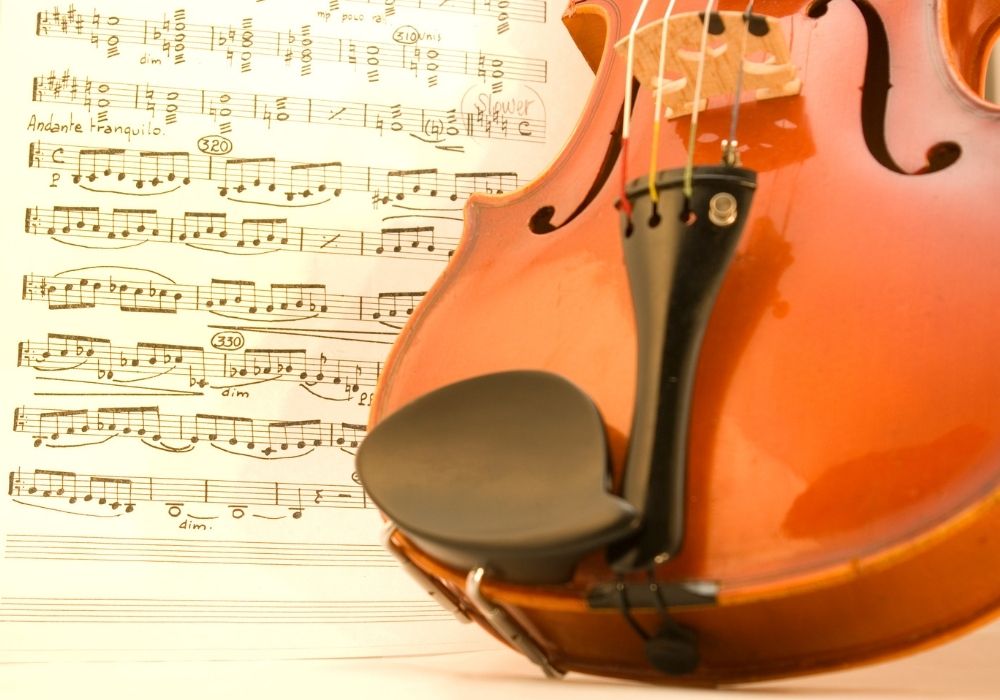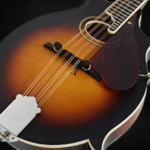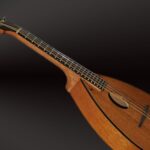When it comes to technique books for beginning viola, the choices are overwhelming at first glance. In this guide, I’ll help you sort through the options so you can find the best books.
My name is Eilish Spear, and I’m a professional violist and teacher. I’ve spent a lot of time figuring out which technique books for viola are the best.
Quick Look: Best Beginner Viola Books
★ #1 Best Overall Viola Book: Viola Players Ivo-Jan van der Werff ★
- Best Beginner Viola Book: Sevcik Op. 1 Part 1 for Viola
- Best Viola Bow Technique Book: Sevcik Op. 3
- Best Viola Scale Book: Carl Flesch Scale System for Viola
- Best Viola Etude Book: Kreutzer 42 Studies for Viola
- Best Advanced Viola Book: Rode 24 Caprices for Viola
Because playing the viola is quite similar to playing the violin, many viola technique books are just edited versions of popular violin books. But there are several key differences in technique, and it’s important to find resources that are specific to this wonderful instrument.
What Makes a Great Viola Book?
A great viola technique book should be simple and allow you to focus on your technique, tone quality, bow arm, and intonation.

The best books are the ones you can come back to every day, year after year, and always learn new things.
Types of Viola Books
There are many different kinds of viola technique books, including those that focus on scales, bow technique, rhythm exercises and etudes. Below, you’ll find my suggestions for every category.
Overall Technique
Viola books that focus on your overall technique will help you with your posture, how you hold your instrument, your bow arm, and on basic techniques that every violist needs. These books are broad and are a wonderful place to start, but it’s important to note that they can’t go in-depth on every topic.
Scales
These books primarily focus on scales and are incredibly important in improving your intonation, familiarity with your instrument, and left-hand/right-hand coordination.
Bow Control
These books focus primarily on right arm technique and skills, and are important in helping you build control and flexibility for all aspects of your playing.
Intonation and Shifting
These books are an extension of the scale books and help violists refine their shifting skills. They’re also excellent for improving your ear training and intonation.
Rhythm
No musician’s toolbox is complete without a solid foundation in rhythm. While these books aren’t necessarily specific to playing the viola, they’re crucial in improving your skills across all areas of your musicianship.
10 Best Beginner Viola Books
Below, you’ll find my 10 favorite viola technique books. These books might seem very basic at first, but I return to them almost every day. They’re a crucial part of my daily practice.

 1. A Notebook for Viola Players
1. A Notebook for Viola Players
- Author: Ivo-Jan van der Werff
- Length: 80 pages
- Type: Overall technique
- Pros: Comprehensive, detailed, and foundational
- Cons: Very broad
My favorite viola technique book of all time is A Notebook for Viola Players. It was written by one of my long-time mentors, Professor van der Werff, who teaches viola at Rice University and has been a professional violist for 40 years.
Professor van der Werff lays out the main components of viola technique in a manageable and detailed way, including the basics of every area of viola technique.
I return to this book whenever I need to go back to the essentials. It’s a great resource to dip your toes into everything from setup, bow technique, vibrato, shifting, ear training, and rhythm. Even better, Professor van der Werff includes videos for every exercise (see below for an example), so if you’re a visual learner, this is the book for you.
 2. Ševčík Op. 1 Part 1
2. Ševčík Op. 1 Part 1
- Author: Lionel Tertis
- Length: 40 pages
- Type: Overall technique
- Pros: Very simple, concise, and great for any level
- Cons: This book ramps up in difficulty quite fast, so it’s easy to get discouraged. Start at the beginning, and don’t worry about getting through the book quickly.
Ševčík Op. 1 Part 1 is the second book that I return to over and over again. It’s a great way to practice intonation, left-hand technique, left-hand/right-hand coordination, and to improve your ear training. The exercises can occasionally feel repetitive, but this careful, methodical work will transform your playing if you stick with it.
 3. Scale System: Scale Exercises in All Major and Minor Keys for Daily Study
3. Scale System: Scale Exercises in All Major and Minor Keys for Daily Study
- Author: Carl Flesch
- Length: 112 pages
- Type: Scales
- Pros: Comprehensive and extremely detailed
- Cons: Includes everything from basic technique to very advanced skills, so students need to figure out what they need from it
The Carl Flesch Scale Book is the most comprehensive scale book out there. It’s great for starting your daily scale practice, practicing intonation, and practicing left-hand/right-hand coordination.
It includes a huge range of skills, so I suggest that students start out with the first few exercises in each key and work their way slowly through the others, once they’ve mastered the basics.
 4. Ševčík Op. 3
4. Ševčík Op. 3
- Author: Margaret Major
- Length: 24 pages
- Type: Bow control
- Pros: Everything you need to master your right arm technique
- Cons: Only for your bow arm
Ševčík Op. 3 is the best comprehensive right-arm technique book I’ve found. It’s great for practicing your tone quality, bow control, and every possible bow technique out there. To practice, start with your metronome much lower than the suggested tempo, and slowly work your way up, noticing how your technique adapts to each new speed.
 5. Ševčík Op. 8
5. Ševčík Op. 8
- Author: Lionel Tertis
- Length: 21 pages
- Type: Intonation and shifting
- Pros: Excellent for beginning shifting technique
- Cons: Moves quickly, so focus on mastering the first few exercises before moving on
Ševčík Op. 8 is a great book for practicing your shifting technique, left-hand setup, and intonation. It’s also a wonderful tool for improving your listening skills, which is a vital component of any violist’s toolkit. I love this book because it forces me to slow down, move thoughtfully, and listen carefully.
 6. Rhythmic Training
6. Rhythmic Training
- Author: Robert Starer
- Length: 86 pages
- Type: Rhythm
- Pros: Comprehensive exercises for almost any rhythm
- Cons: Not specifically for viola
Rhythmic Training is the best rhythm exercise book out there and will help improve every aspect of your musicianship. While it’s not specifically directed towards viola technique, this book has helped me become a better musician in many different ways.
 7. Viola Spaces: Contemporary Viola Studies
7. Viola Spaces: Contemporary Viola Studies
- Author: Garth Knox
- Length: 28 pages
- Type: Overall technique
- Pros: Incredible resource for contemporary viola technique
- Cons: Only focused on extended technique, and doesn’t focus on the more universal aspects of viola technique
Garth Knox wrote this book to provide violists with a technique book that addresses the aspects of viola playing that lots of contemporary music, or other genres, require. This is a really wonderful collection of exercises if you want to learn about new sounds and different ways of playing.
If you play genres outside of classical music, the Viola Spaces is also a great resource for getting to know the extent of your instrument’s capability. It’s also very fun.
 8. School of Viola Technique
8. School of Viola Technique
- Author: Schradieck
- Length: 27 pages
- Type: Beginning etudes
- Pros: The best book for beginning level etudes, and is a great book for improving finger dexterity, intonation, and rhythm.
- Cons: Repetitive
The School of Viola Technique is my all-time favorite etude book. It’s a great way to warm up on your instrument when you first start your practice sessions. I return to it over and over again to work on intonation, finger dexterity, and overall technique.
 9. 42 Studies for Viola
9. 42 Studies for Viola
- Author: Kreutzer
- Length: 63 pages
- Type: Intermediate etudes
- Pros: A great intermediate etude book that covers a wide range of skills, without sacrificing musicality
- Cons: Wide range of difficulty, so not everything is beginner friendly
I love Kreutzer’s 42 Studies because of the wide range of techniques they cover. They’re also often quite beautiful, which makes the difficulty of practicing etudes far more enjoyable. This is a famous etude book, adapted from the original version for violin, and almost every violinist and violist is familiar with this book.
 10. 24 Caprices
10. 24 Caprices
- Author: Pierre Rode
- Length: 64 pages
- Type: Advanced etudes
- Pros: Includes every technique you’ll ever need
- Cons: This collection is very advanced and should not be attempted until you’re at a high level
Rode’s 24 Caprices is the quintessential etude book. If you can play these etudes, you can do almost anything you’ll ever need to do on the viola. It’s excellent for improving your bow control, intonation, rhythm, and musicality.
This book is also quite difficult, so I don’t recommend it to anyone but the most advanced players. But don’t let that intimidate you. After you’ve worked through all the other recommended books and are very comfortable on your instrument, these are a beautiful treat to enjoy.
Review This Post
Table of Contents
In Conclusion
There are so many choices when it comes to beginning viola books, viola technique, and etudes, but there are also a few standouts. I hope this guide has given you an understanding of what’s out there, along with suggestions for the best books for you, wherever you are on your viola journey.














